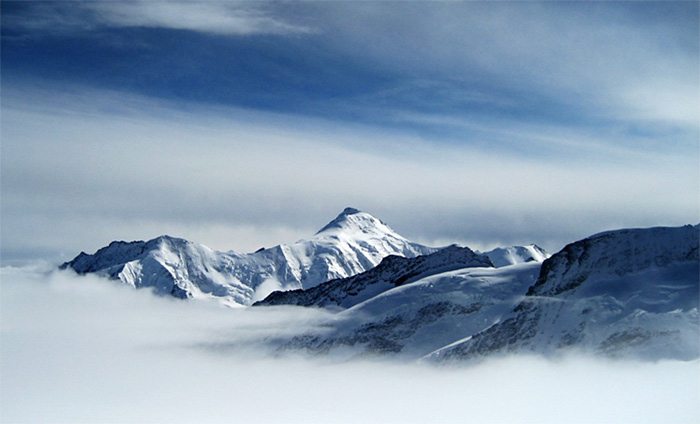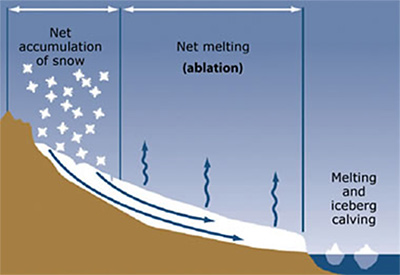
Credit: 4000er (own work; public domain), via Wikimedia Commons
Seventy-five years ago, a married couple went walking in the Swiss Alps and never came back. What became of them was a mystery—until recently, when their bodies were discovered in a glacier.
Glaciers form when winter snow does not melt in summer. Some of it lasts till next winter’s snow, which covers and compresses it.
More years of snow add more weight, which eventually compacts the layers into ice.
Glaciers that continue to add snow and weight eventually become heavy enough to move downhill. They bend, flow, and can even fold on themselves, and that movement could have destroyed our Swiss couple’s bodies.
But it didn’t. This glacier was very stable, not moving much, the amount of winter snow balanced with the amount of summer melt.
Instead, in the cold, very dry environment, the bodies essentially freeze-dried, preserving them there through the decades.
Until now: 2014, ’15, and ‘16 were warmer years and glaciers in the region have begun to shrink.
A patrol crossing the area, on one of their regular paths, found the remains of the couple melting out of the ice.
Their children, now in their 70s and 80s with children and grandchildren of their own, breathed a sigh of relief: they could finally lay their parents to rest in the town cemetery.
They chose to wear white to the funeral, rather than black, to symbolize the hope they always held out, to one day reclaim them from the mountains.
Background

Credit: USGS
Synopsis: Glaciers cover 10% of Earth’s land area and hold more than two-thirds of its fresh water. But how do glaciers form and how do they move?
- Glaciers take decades to centuries or longer to form. When snowfall in an area is much greater than snowmelt over many years, thick layers of snowpack accumulate.
- Hexagonal snowflakes pack together tightly as they become deeply buried.
- With increasing pressure, the snowflakes compress and refreeze into a grainy snow, then into rounded ice pellets, and finally into ice crystals that can grow as large as baseballs.
- Year after year, layers accumulate on top of each other. Once they are buried more than150 ft deep, the crystals fuse into a mass of solid ice. Then, the glacier begins to move under its own weight.
- As glaciers move, the zone where they are recharged by snow is called the zone of accumulation; the zone where they are melting and calving is called the zone of wastage.
- Glaciers are extremely erosive rivers of ice that slowly grind downhill and deform plastically under their own weight as snow continues to accumulate and feed the glacier at its source.
- Glaciers plow up rock and soil as they advance, scouring deep grooves that can be used to figure out the direction the glacier moved. When they retreat, they leave the till—made of poorly sorted boulders, gravel, sand, and mud—they plowed up behind as narrow ridges called moraines along the sides (lateral), underside (medial), and front end (terminal) of the glacier.
- Most glaciers move about 1 ft per day.
- The bottom of glaciers generally moves slower than the top because of friction.
- Occasionally, pressure from the weight of a glacier may cause melting at its base, creating a lubricating layer that enables it to move by basal sliding. These quicker-moving glaciers, referred to as ice streams, generally move more than 8 ft a day.
- The largest glacier in the world—the Lambert Glacier in Antarctica—is an ice stream that moves 10 ft per day. It is more than 8,000 ft thick, 60 miles wide, and 250 miles long, and it drains 8% of the Antarctic ice sheet.
- The world’s fastest-moving glacier is the Jakobshavn Glacier in East Greenland. In 2012, it was advancing about 150 ft per day because meltwater on its surface was percolating through to its base 4,000 ft below, creating an extreme case of basal sliding. As it rushes to the sea, the Jakobshavn Glacier calves many large icebergs—in fact, one of its icebergs is believed to have caused the sinking of the Titanic in 1912.
- Glacial ice that looks blue is highly compressed. It absorbs a bit of red light, causing a bluish tint. Glacial ice that is white is less dense and still contains air.
- Well-preserved mummies recently have been found in glaciers in Switzerland.

